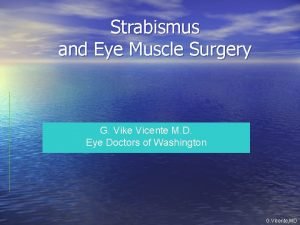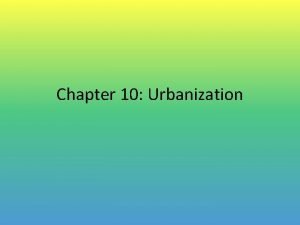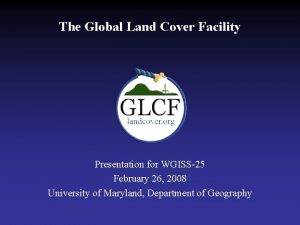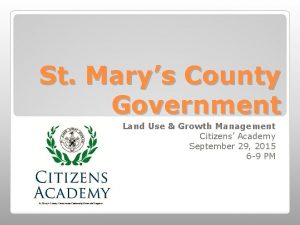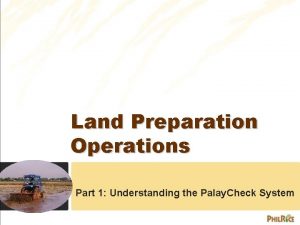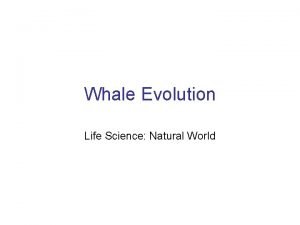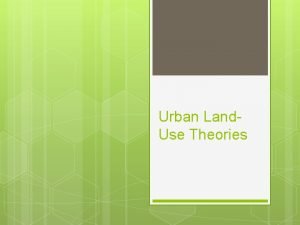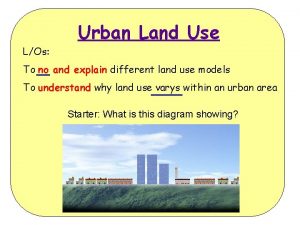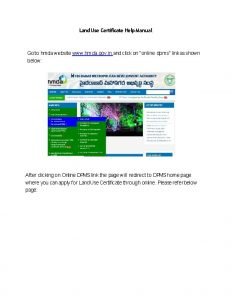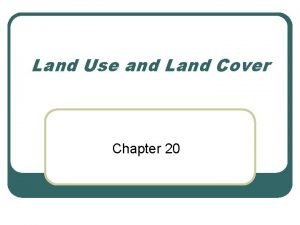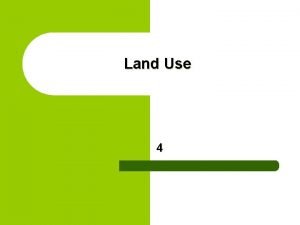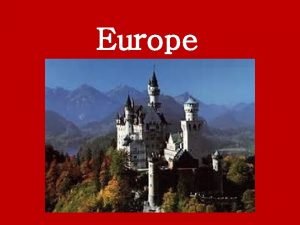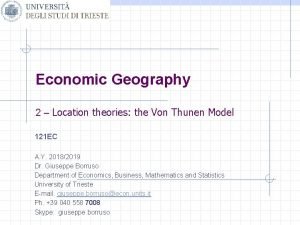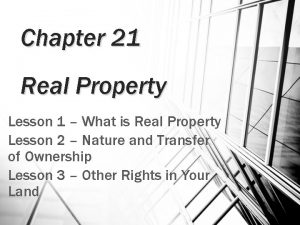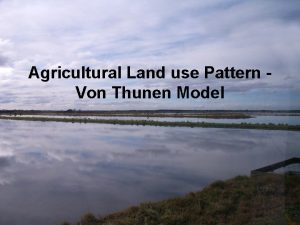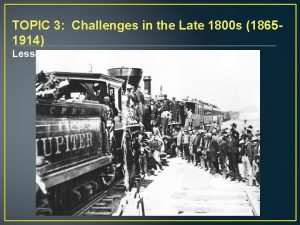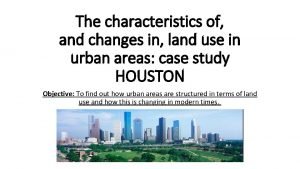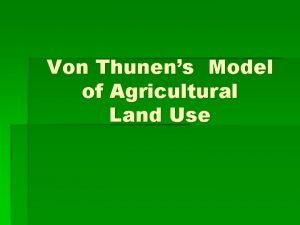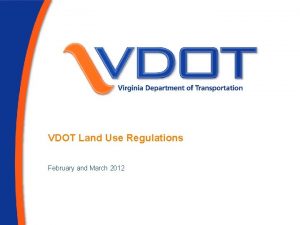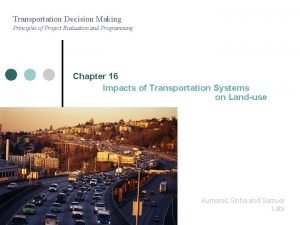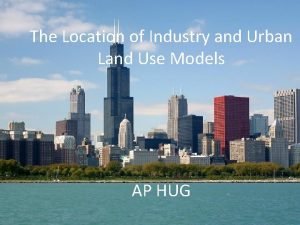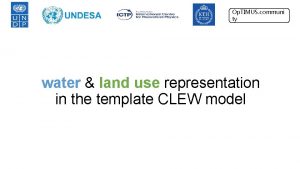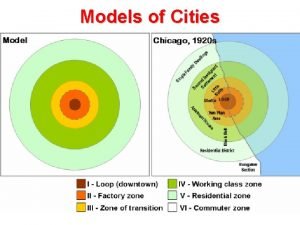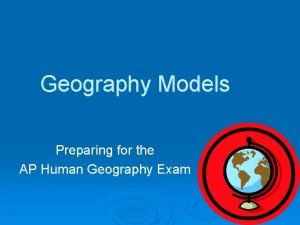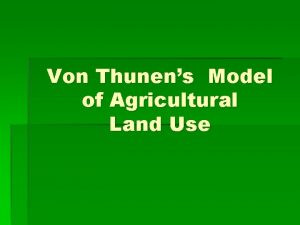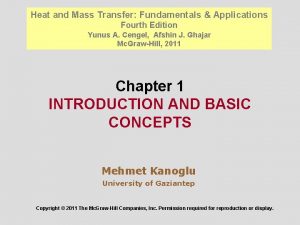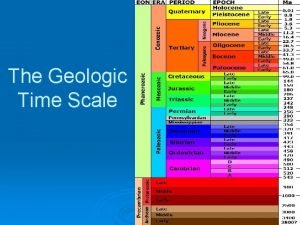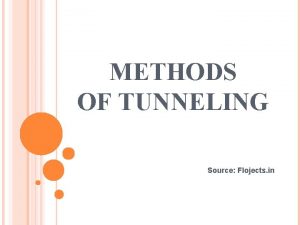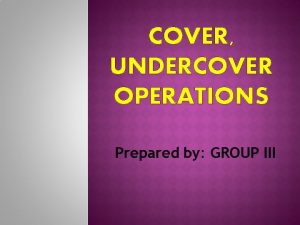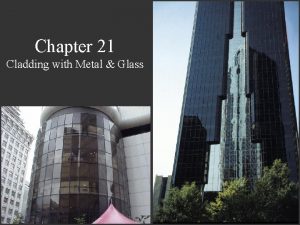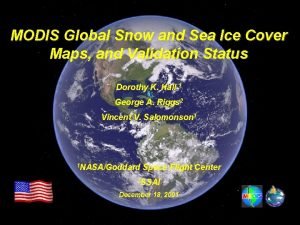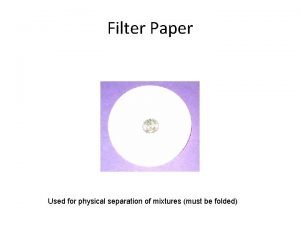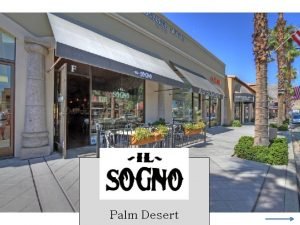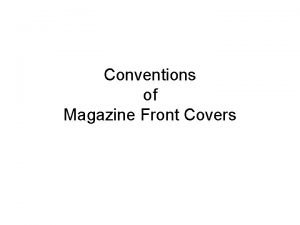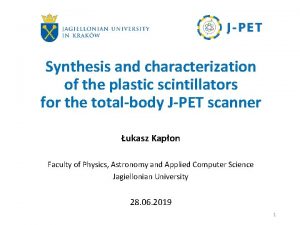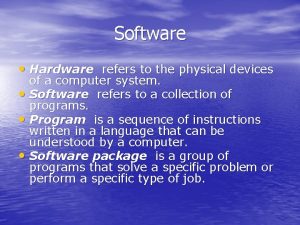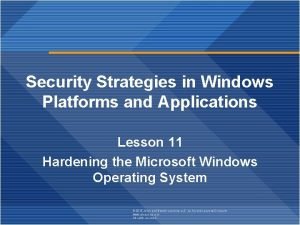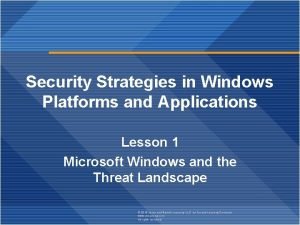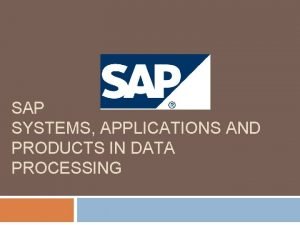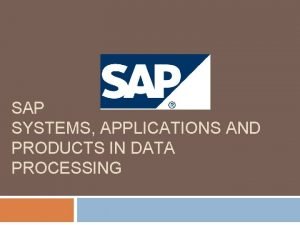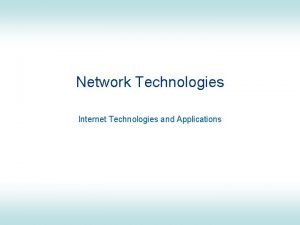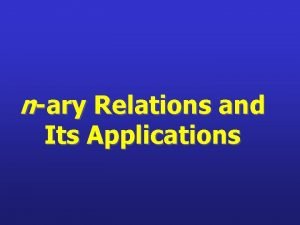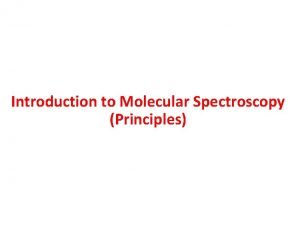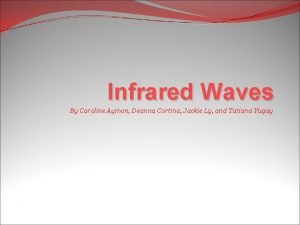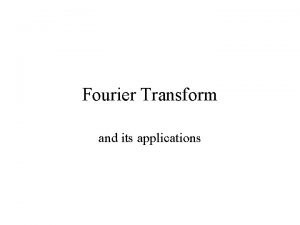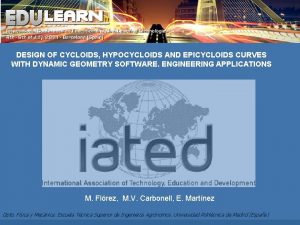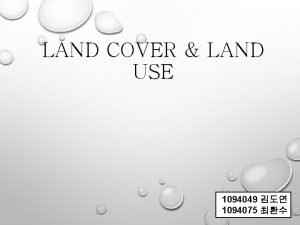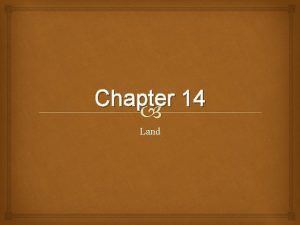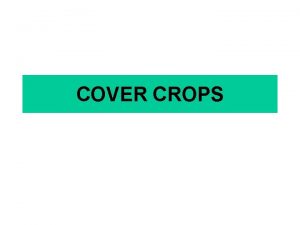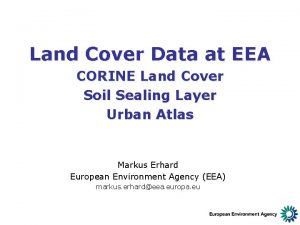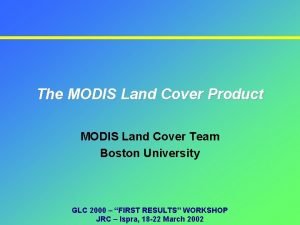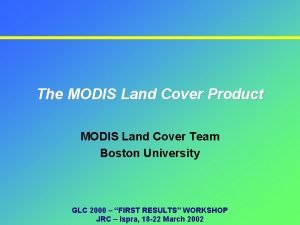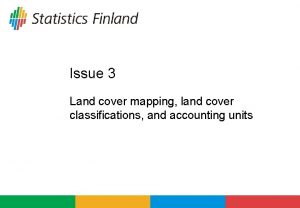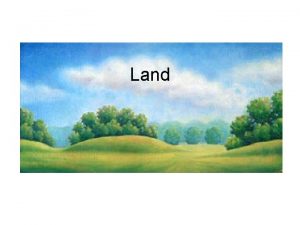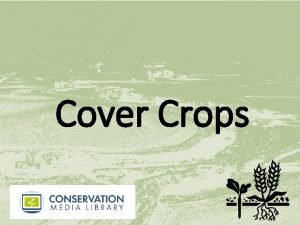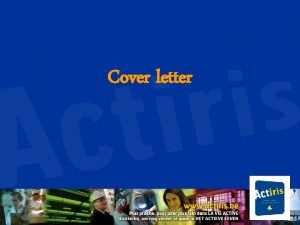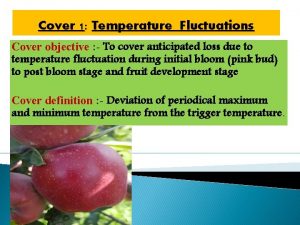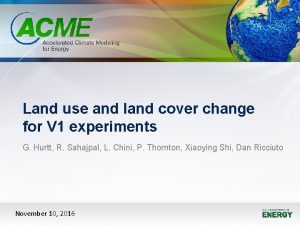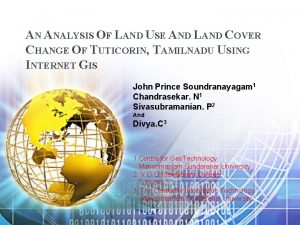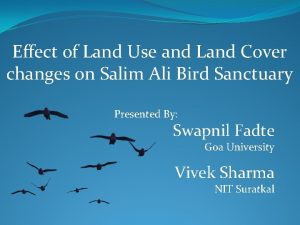Land Cover and Land Use LCLU applications From



































































- Slides: 67

Land Cover and Land Use (LCLU) applications From ESA Advanced Training course on Land Remote Sensing by Mário Caetano www. randbe. es

Sum mar y 1 Setting the scene: some definitions 2 The need for LCLU data LCLU: a cross-cutting environmental variable Relation between two European initiatives (GMES and INSPIRE) and LCLU and environmental legislation LCLU and the DPSIR framework 3 LCLU mapping At country level (the case study of the USA) At European level (GSE Land GMES FTS Land) At Global level (GLG 2000, MOD 12 Q 1 and GLOBCOVER) www. randbe. es

1 Setting the scene: some definitions 2 The need for LCLU data LCLU: a cross-cutting environmental variable Relation between two European initiatives (GMES and INSPIRE) and LCLU and environmental legislation LCLU and the DPSIR framework 3 LCLU mapping At country level (the case study of the USA) At European level (GSE Land GMES FTS Land) At Global level (GLG 2000, MOD 12 Q 1 and GLOBCOVER) www. randbe. es

A definition of land… “'A delineable area of the earth's terrestrial surface, embracing all attributes of the biosphere immediately above or below this surface, including: • near surface climate, • soil and terrain forms, • surface hydrology including shallow lakes, rivers, marshes and swamps, • near-surface sedimentary layers and associated groundwater and geohydrological reserves, • plant and animal populations, • human settlement pattern and physical results of past and present human activity (terracing, water storage or drainage structures, roads, buildings, etc. ). " Source: Interdepartmental working group on land use planning -FAO (2004) www. randbe. es

Land cover versus Land use Land cover (LC) - Physical and biological cover of the earth's surface including artificial surfaces, agricultural areas, forests, (semi-)natural areas, wetlands, water bodies. Land use (LU) - Territory characterised according to its current and future planned functional dimension or socio–economic purpose (e. g. residential, industrial, commercial, agricultural, forestry, recreational). Functional definition of LU description of land in terms of its socio-economic purpose (e. g. agricultural, residential, forestry) LU can be inferred from LC Sequential definition of LU description of land based on series of operations on land, carried out by humans, with the intention to obtain products and/or benefits through using land resources. LU cannot be inferred from LC. Other information sources are needed. Source: INSPIRE Directive www. randbe. es

A possible LC classification • Artificial surfaces o Urban fabric o Industrial, commercial and transport units o Mine, dump and construction sites o Artificial, non-agricultural vegetated areas • Agricultural areas o Arable land o Permanent crops o Pastures o Heterogeneous agricultural areas • Forests • (semi-)natural areas o Scrub and/or herbaceous vegetation associations o Open spaces with little or no vegetation • Wetlands o Inland wetlands o Maritime wetlands • Water bodies o Inland waters o Marine waters • www. randbe. es Source: INSPIRE Drafting Team "Data Specifications“ (2007)

A possible LU classification The ISIC system for LU classification 17 sections, 60 divisions, 159 groups and 292 classes Agriculture, Hunting and Forestry Fishing Mining and Quarrying Manufacturing Electricity, Gas and Water Supply Construction • • The 17 sections of the first level characterize main economic activities. Wholesale and Retail Trade, Repair of motor vehicles, motorcycles and Personal and household goods Hotels and Restaurants Transport, Storage and Communication Financial intermediation Real estate, Renting and Business activities Public Administration and Defense, Compulsory social security Education Health and Social work Other Community, Social and Personal Service Activities Private Households with Employed Persons Extra-territorial Organizations and Bodies • Source: ISIC - International Standard Classification of all Economic Activities www. randbe. es

Sum mar y 1 Setting the scene: some definitions 2 The need for LCLU data LCLU: a cross-cutting environmental variable Relation between two european iniciatives (GMES and INSPIRE) and LCLU and environmental legislation LCLU and the DPSIR framework 3 LCLU mapping At country level (the case study of the USA) At European level (GSE Land GMES FTS Land) At Global level (GLG 2000, MOD 12 Q 1 and GLOBCOVER) www. randbe. es

The need for LCLU data Hydrology Biogeochemical cycles Biodiversity LCLU Ecology The most important environmental variable Soil erosion Climate change Natural disasters Epidemiology Sustainability Land management www. randbe. es

The need for LCLU data Policy makers (e. g. DG from EC, EEA, National, Member States Agencies) Research bodies Agencies responsible for policy implementation and enforcement Users of LCLU information Information providers NGOs and the public Industries and businesses that are often the target of policy www. randbe. es

For many years the research emphasis has been on the classification step itself. Image classification at pixel level Map of categorical classes Does it satisfy the user needs? New classification algorithms Recent research A new spatial unit of analysis Spatial analysis for map generalisation www. randbe. es Redefine the approach for thematic information extraction

LCLU is recognised as one of the most important types of spatial data in two important European initiatives INSPIRE GMES Global Monitoring for Environment and Security Infrastructure for Spatial Information in the European Community COM (2004) 65 final – GMES: Establishing a GMES capacity by 2008 - (Action Plan (2004 -2008)) Directive 2007/2/EC COM(2005) 565 final - GMES: From Concept to Reality COM(2008) 748 final - GMES: We care for a safer planet ESA Web site http: //www. esa. int/esa. LP/LPgmes. html EC Web site http: //www. gmes. info/ or http: //ec. europa. eu/gmes www. randbe. es http: //www. ec-gis. org/inspire/

GMES is a joint initiative of the EC and the ESA, designed to establish a European capacity for the operational delivery and use of information in support of Environment and Security policies. It provides autonomous and independent access to information for policy-makers, particularly in relation to environment and security. ESA implements the space component and the EC manages actions for identifying and developing services. GMES will use, to the maximum extent possible, existing capacities in Member States or at European level. GMES is the European contribution to the Global Earth Observation System of Systems (GEOSS) Services Space systems (in 2005 61 countries agreed on a 10 -year GEOSS implementation plan). GMES In situ systems Data integration and information management www. randbe. es

INSPIRE is a Directive proposed by the EC in July 2004 setting the legal framework for the establishment and operation of an Infrastructure for Spatial Information in the European Community. The purpose of INSPIRE is to support the formulation, implementation, monitoring activities and evaluation of Community policies and activities that may have a direct or indirect impact on the environment at various levels of public authority, European, national and local. The components of INSPIRE infrastructures include: metadata; spatial data themes; spatial data services; network services and technologies; agreements on data and service sharing, access and use; coordination and monitoring mechanisms, processes and procedures. INSPIRE should be based on the infrastructures for spatial information that are created and maintained by the Member States will also ensure that the information is shared between public bodies and they would take steps to make geographical information more coherent. Member States would make accessible their existing public sector geographical information over the INTERNET. www. randbe. es

INSPIRE Building the European Spatial Data Infrastruture Source: EEA www. randbe. es

The need for LCLU data Landscape characterisation (composition, condition and dynamics) As surrogate/proxies for other variables Input for environmental models • Atmospheric emissions in air quality models • Potential for food production in models of food security • Fuel availability in models of wildfire risk • Ground permeability in flood risk models www. randbe. es

Ultimately LCLU data is important for policy on environment • to help guide policy formulation and development • to help monitor and enforce the implementation of these policies • to assess the impact of existing or planned policies • to maintain a watching brief in order to identify the need for new policy action DPSIR system has been widely adopted as a framework for policy analysis The need for LCLU monitoring www. randbe. es

The need for LCLU data EU Policy areas • Environmental thematic strategies on urban environment, soil protection and sustainable use of natural resources; • Reporting obligations under the Water framework directive, management of Natura 2000 sites, • Environmental impact assessments and reporting; • Regional policies, territorial cohesion and European spatial development perspectives; • Common Agricultural Policy (CAP); • Common Transport Policy; • EU Development Policies (i. e. sustainable development and poverty reduction, food security); • Infrastructure for spatial information in Europe – INSPIRE and ESDI. International Environmental Agreements • the three Rio Conventions: o. UN Framework Convention on Climate Change (UNFCCC) and its Kyoto Protocol, o UN Convention to Combat Desertification (UNCCD), o UN Convention on Biological Diversity (UNCBD), • the UN-ECE Long Range Transboundary Air Pollution Deposition and dispersion modelling, . Other international conventions/agreements • UN Forum on Forest with the related “FLEGT ” policy whereby EU contributes to the transparency of the international timber market, • UN Millennium Development Goals, where Goal I pledges to improve food and nutrition security, • Ramsar Convention on Wetlands. Source: IG-LMCS (2007) GMES Global Land Working Group, 2008 www. randbe. es

The need for LCLU data EU Policy and legal framework Information requirement Water Framework directive (2006 -2015+) Community Biodiversity Strategy (2006 – 2010+) Habitats directive Natura 2000, 2010 target Common Agriculture Policy (agri-environmental Regulation; New guidelines for Rural Development; CAP evaluations 2007 -2013) Characterization of river catchment areas, prevention of groundwater pollution from diffuse and local soil contamination Designated areas and habitats, change in ecosystems, fragmentation Landscape diversity and management, agriculture habitats, mapping rural area Community Structural Policies (European Spatial Development Perspective – Territorial Cohesion; 2007 -13 ) Natural assets, land use conflicts, physical planning, territorial development Follow up European Strategy for ICZM (2006+) Land use and land cover change coastal zones European Thematic Strategy on Urban Environment and sustainable land use (2006+) European Thematic Strategy on Soil Protection (2006+) Urban sprawl, rural-urban relationships … … Soil degradation, protection and sealing www. randbe. es Source: EEA

The DPSIR framework to report on environmental issues LCLU data is needed throughout the entire DPSIR chain. Source: EEA www. randbe. es

DPSIR for terrestrial environments Driving Forces Pressure State Impact Responses Source: EC (2004) www. randbe. es

The diversity of needs for LCLU information Source: EC (2004) www. randbe. es

Sum mar y 1 Setting the scene: some definitions 2 The need for LCLU data LCLU: a cross-cutting environmental variable Relation between two European initiatives (GMES and INSPIRE) and LCLU and environmental legislation LCLU and the DPSIR framework 3 LCLU mapping At country level (the case study of the USA) At European level (GSE Land GMES FTS Land) At Global level (GLG 2000, MOD 12 Q 1 and GLOBCOVER) www. randbe. es

Sum mar y 1 Setting the scene: some definitions 2 The need for LCLU data LCLU: a cross-cutting environmental variable Relation between two European initiatives (GMES and INSPIRE) and LCLU and environmental legislation LCLU and the DPSIR framework 3 LCLU mapping At country level (the case study of the USA) At European level (GSE Land GMES FTS Land) At Global level (GLG 2000, MOD 12 Q 1 and GLOBCOVER) www. randbe. es

US National Land Cover Database (NLCD) In 1992 several federal agencies of the US agreed to operate as a consortium in order to acquire satellite-based remotely sensed data for their environmental monitoring programs, i. e. Multi-Resolution Land Characteristics Consortium (MRLC) http: //www. epa. gov/mrlc/ http: //www. mrlc. gov/ www. randbe. es

US National Land Cover Database (NLCD) MCRL has been the umbrella for many US programs, which require landcover data for addressing their agency needs, namely the 2 National Land Cover Databases: NLCD 1992 A single product: a land cover map Vogelmann et al. (2001) NLCD 2001 Multiple products: land cover map, percent tree canopy and percent urban impervious. Homer et al. (2007) NLCD 2006 NLCD 1992 Under development http: //www. epa. gov/mrlc/nlcd-2006. html NLCD 2001 NLCD 2006 www. randbe. es

Thematic information extraction from satellite images 1 Definition of the mapping approach 2 Geographical stratification 3 Image segmentation 4 Feature identification and selection 5 Classification 6 Ancillary data integration 7 Post-classification processing 8 Accuracy assessment * * * mandatory www. randbe. es

US National Land Cover Database (NLCD) - 2001 Source: Homer et al. (2004) www. randbe. es

US National Land Cover Database (NLCD) - 2001 Decision Tree (See 5) Regression Tree (See 5) Mapping Zone Input Layers Land cover map Percent tree canopy Percent urban impervious Source: Homer et al. (2007) www. randbe. es

US National Land Cover Database (NLCD) - 2001 Source: Homer et al. (2007) www. randbe. es

Sum mar y 1 Setting the scene: some definitions 2 The need for LCLU data LCLU: a cross-cutting environmental variable Relation between two European initiatives (GMES and INSPIRE) and LCLU and environmental legislation LCLU and the DPSIR framework 3 LCLU mapping At country level (the case study of the USA) At European level (GSE Land GMES FTS Land) At Global level (GLG 2000, MOD 12 Q 1 and GLOBCOVER) www. randbe. es

Land in GMES http: //www. gmes-geoland. info/ http: //www. gmes-gseland. info Source: IG-LMCS (2007) http: //www. gmes-forest. info/ www. randbe. es

GSE-Land (GMES Service Element Land) GSE Land Services portfolio has been structured in four service areas: Land Take monitoring -> Cohesion policies, ESDP, ESPON Diffuse Pollution ->WFD, linking to CAP Water Abstraction by Agriculture -> WFD, water management Urban. Audit from DG ENV/DG REGIO WFD – Water Framework Directive; ESDP - European Spatial Development Perspective, ESPON - European Spatial Observatory Network Source: http: //www. gmes-gseland. info www. randbe. es

GSE Land - Regional Land cover map (M 2. 1) Source data: Landsat 5 TM & Landsat 7 ETM+, or SPOT 2, 4, 5 (10/20 m multispectral, 5 m PAN), or IRS 1 C/D PAN and MS Saar-Mosel catchment Scale 1: 50. 000 ; MMU = 1 ha (artificial surface) and 5 ha (non artificial); Source: http: //www. gmes-gseland. info www. randbe. es

GSE Land - Urban Atlas Madrid Source data: SPOT 5 – XS (10 m) and -PAN (2, 5 m) Scale 1: 10. 000 ; MMU = 0, 25 ha ; MDL = 10 m Pre-processing, geocoding, segmentation, -classification, visual interpretation, accuracy assessment The basic urban land use information is enhanced by soil sealing mapping (up to 11 classes). Source: http: //www. gmes-gseland. info www. randbe. es

GSE Land – soil sealing Spot-5 satellite image Urban outline Sealing levels Source: GSE-Land www. randbe. es

GSE Land - Urban audit indicators “green urban area” and “public open areas” are extracted from the urban atlas and local population statistics. Source: http: //www. gmes-gseland. info www. randbe. es

GSE Land M 2. 6 Land Take map (first inventory) M 2. 4 Land Take map (change) Source data: SPOT 5 MS; or SPOT 4 PAN or IRS PAN & LISS Scale 1: 25. 000 ; MMU = 0, 25 ha (artifical surface) and 1 ha (nonartificial); MDL = 10 m Assessment of sealed surfaces concerning its relation to demographic data and trends during 3 -5 years observation time. Analysis is based on modelling of residential population distribution using EO derived sealing intensity and demographic data. This information is combined with various datasets to illustrate its linkages with environmental pressures, trends in land consumption, and quality of life aspects. Source: http: //www. gmes-gseland. info www. randbe. es

GMES Land Monitoring Core Service The implementation of GMES started with three “Fast Track” Services (FTS) addressing Land Monitoring, Marine Monitoring and Emergency Response. The goal of the GMES Land Monitoring Service is to provide timely, continuous and independent observations about the use of soil and other land resources and the changes of the land environment for responsible and farsighted policy-making at all levels, from local to global. Source: IG-LMCS (2007) www. randbe. es

GMES Land Monitoring Core Service The GMES Land Monitoring Service includes: (1) Fast Track Services • Continental component – a LC (+ changes) map for Europe • Local component – high resolution maps of built-up areas (1) Service evolution • Global component – e. g. land cover, biophysical parameters, and more thematic data on desertification, deforestation, food security • Thematic layers – at both local and continental level, dedicated to specific European and MS policies (e. g. soil protection, agriculture, hydrological maps) Source: IG-LMCS (2007) www. randbe. es

GMES FTS Land participating countries 38 countries with total area of 5. 8 Mkm 2 Source: ETC-LUSI (2007) www. randbe. es

GMES FTS Land products CLC 2006 Built-up area / sealing CLC Changes Source: EEA www. randbe. es

GMES FTS Land products GMES FTS Land resumes the tradition of the 1990 and 2000 CORINE Land Cover (CLC) databases CLC map (CLC 90; CLC 2000 and CLC 2006) CLC changes (1990 -2000 and 2000 -2006) MMU = 25 ha MMU = 5 ha Methodology: computer assisted visual interpretation of satellite images Source data: CLC 90 and CLC 2000 Landsat MSS, TM and ETM+ CLC 2006 SPOT-4 and IRS LISS III (dual date) Nomenclature: hierarchical with 44 classes Thematic accuracy >85% Source: EEA www. randbe. es

Intensification of agriculture infrastructure development Urban sprawl A new dam www. randbe. es Source: ETC-LUSI

Image 2000 CLC 2006 Ancillary data Image 2006 CLC-changes www. randbe. es

Urban areas 50. 0 41. 2 4 12 28 18 32 Agriculture 4 10 30. 0 20. 0 10. 0 2. 8 0. 0 -1. 1 -8. 6 12 1 -20. 0 72 Urban areas Natural vegetation -3. 6 -10. 0 8 19 Forest Crescimento em relação a 1985 (%) 21 33 40. 0 9 6 Agriculture with natural areas Forest Land cover change from 1985 to 2000 in Portugal (thousands of ha) www. randbe. es Natural vegetation

CORINE Land Cover 2000 (100 m grid) High-resolution layer for built-up areas 2000 Prague Source: EEA Source: GSE SAGE; Producer: Geo. Ville / GISAT Artificial surfaces Nonartificial surfaces www. randbe. es

High-resolution layer for built-up areas 2006 Artificial surfaces Nonartificial surfaces Source: EEA www. randbe. es

GMES FTS CLC 2006 (MMU=25 ha) R&D High resolution maps (built-up areas and forests) CLC-changes 2000 -2006 (MMU=5 ha) LC map with approximately 20 classes with 1 ha (or less) MMU (updating periodicity – 3 to 5 years) The goal: a GMES LAND MONITORING PILOT SERVICE by 2008 If LC-20 classes satisfies user requirements then it will replace the current CLC databases in 2010 Otherwise, CLC will be produced in 2010 Issues to be addressed in the development phase • automatic and robust land cover classification techniques at pan-European scale • use of multi-seasonal and multi-sensor images for improving the land cover classes discrimination • change detection tools which can be used to reduce the updating efforts • overall validation methods at pan-European level • aggregation/generalization techniques to move from local (MS) land cover/land use mapping to continental one www. randbe. es

GMES Land Monitoring Core Service The GMES Land Monitoring Service includes: (1) Fast Track Services • Continental component – a LC (+ changes) map for Europe • Local component – high resolution maps of built-up areas (2) Service evolution • Global component – e. g. land cover, biophysical parameters, and more thematic data on desertification, deforestation, food security • Thematic layers – at both local and continental level, dedicated to specific European and MS policies (e. g. soil protection, agriculture, hydrological maps) Source: IG-LMCS (2007) www. randbe. es

GMES Land Monitoring Core Service Examples of Downstream Services (DS) – Thematic layers Noise mapping the local component of the Core Service (CS) will produce update maps of the major European agglomerates, which could be used by the local authorities as input to maps of the noise intensity and noise dispersion in a DS. Precision farming combining at parcel level land use information from the CS with agronomic models and diagnostic tools for farmers to optimise for example fertilizer input (DS). Management of irrigation DS which needs regular and accurate information on land use from the CS (irrigated/not irrigated crops) to better monitor irrigation at the level of water catchments. Crop Yield forecasts the operational processing chain producing biophysical products and agro-meteorological indicators could be part of the Global Land component of the CS. Then the issuing of bulletin from expert knowledge is an added value product which could be part of a DS. www. randbe. es

GMES Land Monitoring Core Service Global component Land cover and forest change near real time monitoring systems of environmental stress worldwide and slightly differed time monitoring systems of land cover and forest conversion. Natural carbon flux near real time monitoring system of natural carbon fluxes at the land-atmosphere interface. Crop production and food security monitoring systems for the crop production and yield assessment to be operated in near real time, as an input to services in charge of common agricultural policy, food security and trade policies. Biogeophysical variables Soil and Vegetation variables: e. g. land cover, Leaf Area Index, vegetation fractional cover, burnt areas, surface reflectance. Radiation variables : e. g. albedo, surface temperature, down welling radiation flux. Water variables: e. g. soil moisture, evapotranspiration, etc. . . www. randbe. es

Sum mar y 1 Setting the scene: some definitions 2 The need for LCLU data LCLU: a cross-cutting environmental variable Relation between two European initiatives (GMES and INSPIRE) and LCLU and environmental legislation LCLU and the DPSIR framework 3 LCLU mapping At country level (the case study of the USA) At European level (GSE Land GMES FTS Land) At Global level (GLG 2000, MOD 12 Q 1 and GLOBCOVER) www. randbe. es

Global land cover maps AVHRR Spatial resolution 1º - AVHRR 8 km - AVHRR 1 km Images The 1 st global LC map MODIS LC map Reference year References De. Fries and Townshend (1994) De. Fries et al. (1998) Loveland et al. (2000) MODIS 2001 1 km Friedl et al. (2002) VEGETATION 2000 1 km MERIS 2005 300 m Bartholomé and Belward (2005) Arino et al. (2007) (MOD 12 Q 1) Global Land Cover 2000 (GLC 2000) GLOBCOVER www. randbe. es

GLOBCOVER http: //dup. esrin. esa. it/projects/summaryp 68. asp www. randbe. es

GLOBCOVER The main goal of GLOBCOVER is to develop and demonstrate a service that will produce a global land cover map for 2005, using as main source of data MERIS full resolution data (300 m) GLOBCOVER is intended to update and to complement the other existing comparable global products such as GLC-2000. GLOBCOVER is intended to improve previous global products, in particular through a finer resolution (300 m) The GLOBCOVER system A software system is being developed such that any further update of GLOBCOVER will be at recurrent cost. Source: Defourny et al. (2005) www. randbe. es

GLOBCOVER MERIS FRS (Full resolution full swath) from Dec 2004 until June 2006 are used. ESA made a considerable effort to improve geolocation accuracy. Factors to take into account are the satellite attitude, relief deformation and the resampling procedure. The goal is to have a positional accuracy better than 150 m bi-monthly mosaics Temporal compositing generates seasonal and annual mosaics by averaging the monthly mosaics over the selected period. www. randbe. es Source: Arino et al. (2007)

GLOBCOVER Stratification into equal-reasoning areas It reduces the land cover variability Allows selection of region specific classification parameters (e. g. , temporal synthesis, band combinations, number of classes) To improve discrimination efficiency of the classification algorithms vegetation seasonality snow cover burning period cloud coverage Criteria sun zenith angle data availability Source: Defourny et al. (2005) www. randbe. es

GLOBCOVER Step 1 Definition of homogenous land cover objects Step 2 Derivation of neo-channels Step 3 LC discrimination through iterative multidimensional clustering techniques (spectro-temporal classes) Step 4 Clusters labeling using LCCS Source: Defourny et al. (2005) www. randbe. es

GLOBCOVER The nomenclature of GLOBCOVER is based on the Land Cover Classification System (LCCS) from FAO http: //www. glcn-lccs. org/ Global product – 22 land cover classes Hierarchical tree from LCCS Source: Bartholomé and Belward (2005) www. randbe. es

GLOBCOVER http: //ionia 1. esrin. esa. int/ www. randbe. es

GLOBCOVER http: //ionia. terradue. com/ European Space Agency Ionia Glob. Cover Portal Glob. Cover products distributed as torrent files www. randbe. es

Land information services http: //www. land. eu/ The Land portal provides a common entry point to GMES data-sets across a variety of data repositories across Europe. The data-sets are contributed by EEA, JRC and the GMES projects geoland, Boss 4 GMES, GSE Forest Monitoring, GSE Land Information Services http: //www. land. eu/portal www. randbe. es

Summary 1 Setting the scene: some definitions 2 The need for LCLU data LCLU: a cross-cutting environmental variable Relation between two european iniciatives (GMES and INSPIRE) and LCLU and environmental legislation LCLU and the DPSIR framework 3 LCLU mapping At country level (the case study of the USA) At European level (GSE Land GMES FTS Land) At Global level (GLG 2000, MOD 12 Q 1 and GLOBCOVER) www. randbe. es

References Arino, O. et al. , 2007, Glob. Cover: ESA service for Global Land Cover from MERIS. Proceedings of IGARSS’ 2007, Barcelona (Spain), 23 -27 July, 2007. Bartholomé, E. , and Belward, 2005, GLC 2000: a new approach to global land cover mapping from Earth observation data. International Journal of Remote Sensing, 26(9): 1959 -1977. Bartholomé, E. , Belward, A. S. , Achard, F. , Bartalev, S. , Carmona-Moreno C. , Eva, H. , Fritz, S. , Grégoire, J. -M. , Mayaux, P. And Stibig, H. -J. , 2002, GLC 2000—Global Land Cover Mapping for the Year 2000—project Status November 2002. Publications of the European Commission, EUR 20524 EN (Luxembourg: Office for Official Publications of the European Communities). Defourny, P. , Vancutsem, C. , Bicheron, P, Brockmann, C. , Nino, F. , Schouten, L. , Leroy, M. , 2006, GLOBCPVER: a 300 m global land cover product for 2005 using ENVISAT MERIS Time Series, Proceedings of ISPRS Commission VII Mid-Term Symposium: Remote Sensing: from Pixels to Processes, Enschede (NL), 8 -11 May, 2006. De. Fries, R. S. , & Townshend, J. G. R. , 1994, NDVI derived land cover classifications at a global scale. International Journal of Remote Sensing, 5: 3567– 3586. www. randbe. es

De. Fries, R. , Hansen, M. , Townsend, J. G. R. , and Sohlberg, R. , 1998, Global land cover classifications at 8 km resolution: the use of training data derived from Landsat imagery in decision tree classifiers. International Journal of Remote Sensing, 19: 3141– 3168. Duhamel, C. , 1998, First approximation of a reference land use classification, Report to the FAO. EC, 2004, Building a European information capacity for environment and security. A contribution to the initial period of the GMES Action Plan (2002 -2003). Friedl, M. A. , Mciver, D. K. , Hodges, J. C. F. , Zhang, X. Y. , Muchoney, D. , Strahler A. H. , Woodcock, C. E. , Gopal, S. , Schneider, A. , Cooper, A. , Baccini, A. , Gao, F. And Schaaf, C. , 2002, Global land cover mapping from MODIS: algorithms and early results. Remote Sensing of Environment, 83: 287– 302. GSE Land Team, 2006, GSE Land Service Prospectus; ITD-0421 -RP-0013 -S 3. GMES Global Land Working Group, 2008, Global component of the GMES Monitoring Core Service Homer et al. , 2007, Completion of the 2001 National Land Cover Database for the Counterminous United States. Photogrammetric Engineering and Remote Sensing, 73(4) 337 -341. www. randbe. es

Homer, C. C. Huang, L. Yang, B. Wylie and M. Coan. 2004. Development of a 2001 National Landcover Database for the United States. Photogrammetric Engineering and Remote Sensing, 70 (7): 829 -840 INSPIRE Drafting Team "Data Specifications“, 2007, Definition of Annex Themes and Scope. IG-LMCS (Implementation Group on GMES Land Monitoring), 2007, GMES Fast Track Land Monitoring Core Service Strategic Implementation Plan. Loveland, T. R. , Reed, B. C. , Brown, J. F. , Ohlen, D. O. , Zhu, Z. , Yang, L. , and Merchant, J. W. , 2000, Development of a global land cover characteristics database and IGBP DISCover from 1 km AVHRR data. International Journal of Remote Sensing, 21(6– 7): 1303– 1365. United Nations, International Standard Industrial Classification (ISIC), Rev. 3 http: //unstats. un. org/unsd/cr/registry/regcst. asp? Cl=2 Vogelmann JE, Howard SM, Yang L, Larson CR, Wylie BK and Van Driel N. , 2001, Completion of the 1990 s National Land Cover Data Set for the Conterminous United States from Landsat Thematic Mapper Data and Ancillary Data Sources. Photogrammetric Engineering and Remote Sensing, 67: 650 -662 www. randbe. es
 Lclu
Lclu Cover uncover test vs alternating cover test
Cover uncover test vs alternating cover test Alternate prism cover test
Alternate prism cover test Lancaster red green test interpretation
Lancaster red green test interpretation Uncentered commercial (strip) development
Uncentered commercial (strip) development Glcf data and products
Glcf data and products St. marys county land use and zoning lawyer
St. marys county land use and zoning lawyer Characteristics of a well-prepared upland field
Characteristics of a well-prepared upland field An area of land largely enclosed by higher land
An area of land largely enclosed by higher land Identifying landforms
Identifying landforms How you use ict today and how you will use it tomorrow
How you use ict today and how you will use it tomorrow Cetacean
Cetacean Hoyt model
Hoyt model Urban land use model
Urban land use model Land use planning '' lecture notes
Land use planning '' lecture notes Land use certificate hyderabad
Land use certificate hyderabad Usgs land use classification
Usgs land use classification Types of land use
Types of land use Mixed land use ap human geography definition
Mixed land use ap human geography definition Bid rent theory model
Bid rent theory model Irrevocable rights to some limited use of another's land
Irrevocable rights to some limited use of another's land Von thunen's agricultural land use model
Von thunen's agricultural land use model What contribution did mexicans make to cattle ranching?
What contribution did mexicans make to cattle ranching? Characteristics of land use in urban areas
Characteristics of land use in urban areas Land use planning lecture notes
Land use planning lecture notes Flood hazard area land use management guidelines
Flood hazard area land use management guidelines Assumptions of von thunen model
Assumptions of von thunen model Vdot entrance permit
Vdot entrance permit Land use planning '' lecture notes
Land use planning '' lecture notes Transportation
Transportation Harris ullman multiple nuclei model
Harris ullman multiple nuclei model What is the meaning of land use
What is the meaning of land use Burgess theory of concentric circles
Burgess theory of concentric circles Define land use planning
Define land use planning Concentric zone model
Concentric zone model Six assumptions of von thunen model
Six assumptions of von thunen model Heat transfer
Heat transfer Fuzzy sets and fuzzy logic theory and applications
Fuzzy sets and fuzzy logic theory and applications Cover the greatest expanses and are subdivided into eras
Cover the greatest expanses and are subdivided into eras Clay kicking method
Clay kicking method Under cover operation
Under cover operation Cover letter for personal statement
Cover letter for personal statement Column cover and spandrel system
Column cover and spandrel system Chapter 18:4 participating in a job interview
Chapter 18:4 participating in a job interview Snow and ice cover map
Snow and ice cover map Uses of tripod in laboratory apparatus
Uses of tripod in laboratory apparatus Used for heating of stable solid compounds and elements
Used for heating of stable solid compounds and elements Cover page and index
Cover page and index Slaughter and may cover letter
Slaughter and may cover letter Our hopes and expectations
Our hopes and expectations French classical menu pdf
French classical menu pdf Front magazine covers
Front magazine covers Cro applications
Cro applications Terahertz spectroscopy principles and applications
Terahertz spectroscopy principles and applications Plastic scintillators: chemistry and applications
Plastic scintillators: chemistry and applications Physical devices of a computer
Physical devices of a computer Security strategies in windows platforms and applications
Security strategies in windows platforms and applications Security strategies in windows platforms and applications
Security strategies in windows platforms and applications Systems, applications, products in data processing
Systems, applications, products in data processing System applications and products in data processing
System applications and products in data processing Aim lans
Aim lans N-ary relation
N-ary relation Applications of uv and visible spectroscopy
Applications of uv and visible spectroscopy Jackie ly
Jackie ly Human genetics concepts and applications 10th edition
Human genetics concepts and applications 10th edition The fourier transform and its applications
The fourier transform and its applications Applications of cycloids
Applications of cycloids Application software and system software difference
Application software and system software difference
